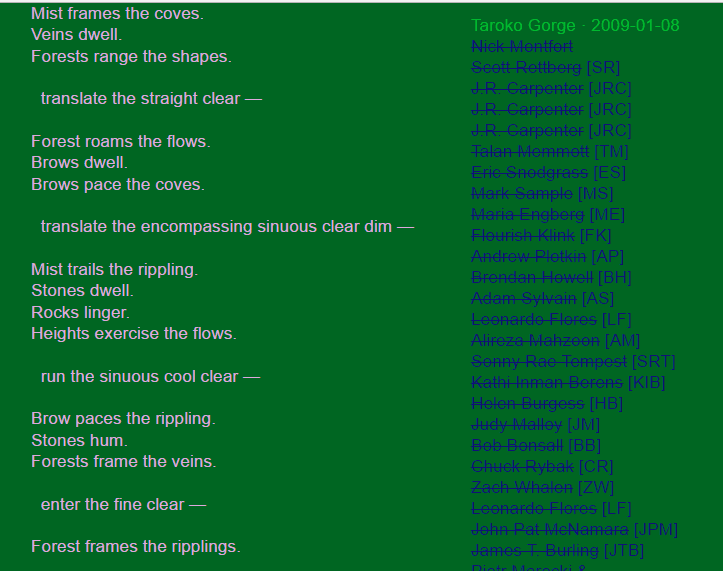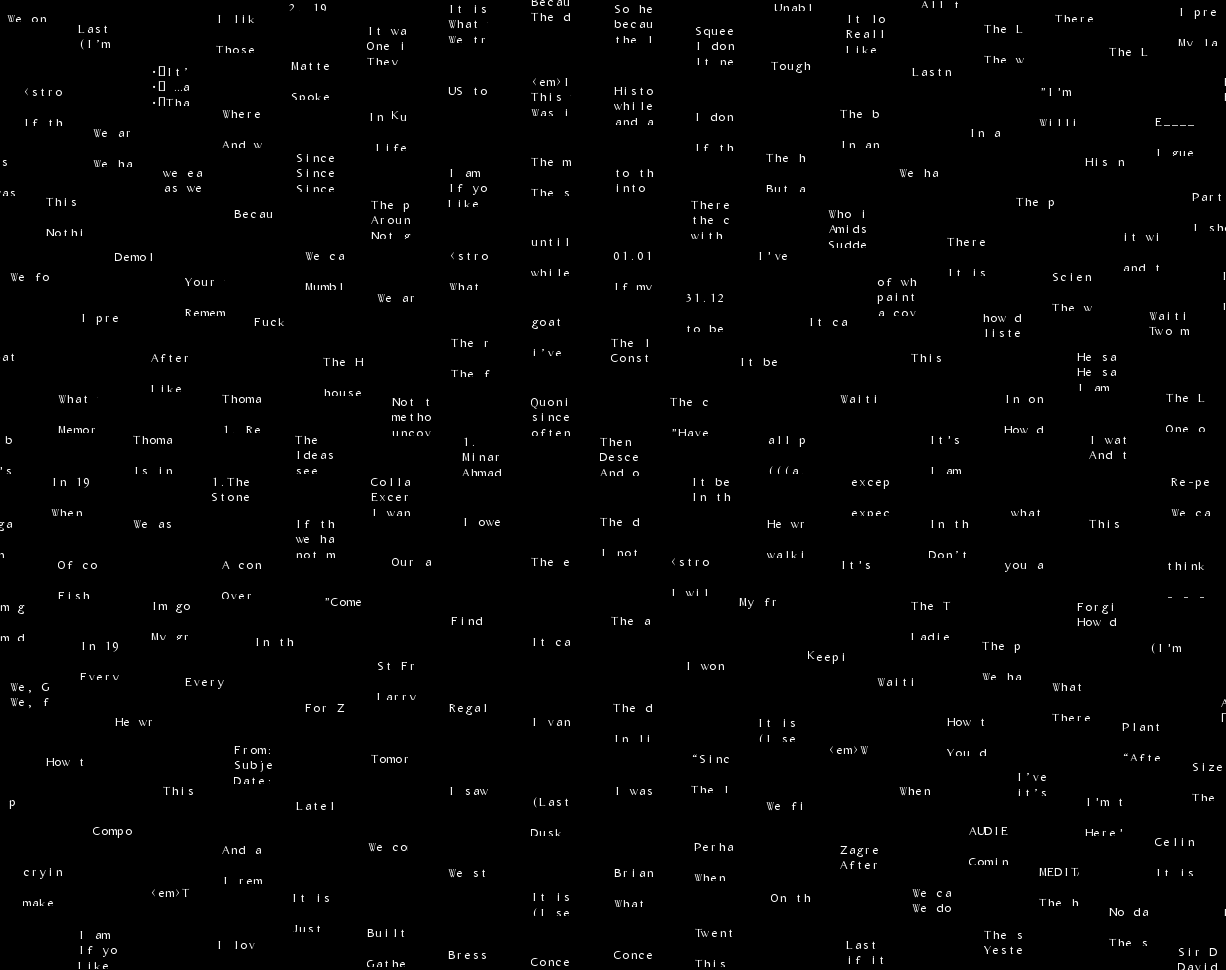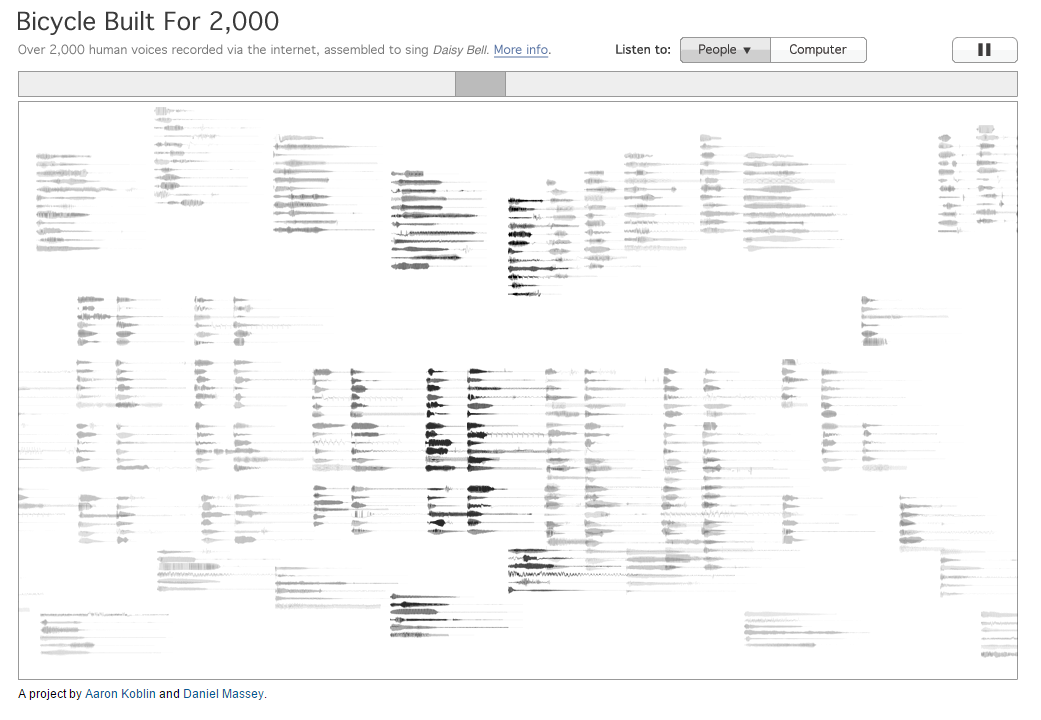4 Digital Poems That Will Make You Rethink What Poetry Is
In Bicycle Built for 2000, each cluster of waveforms represents a single audio clip that was recorded, somewhere in the world, by an unknown participant.
Poetry, in the popular imagination, is usually seen as a solo act. The lone poet bares their soul to the world, writes beautiful tortured lines, etc.
When it comes to electric literature, though, what happens a computer algorithm is thrown into the creative process? Does the computer get copyright? And, most importantly, does it get royalties?
Joking aside, some poets these days are embracing the digital and don’t necessarily write poems the old-fashioned way. Here are some innovative poems that turn the idea of poetry – and the solo poet – on its head.
1.) Taroko Gorge, by Nick Montfort, et al

Taroko Gorge uses a computer algorithm to generate lines of poetry. The sidebar shows versions by writers who have hacked the code to make spinoffs.
At Taroko Gorge in Taiwan, Nick Montfort wrote a poem to celebrate the national park’s awesome beauty. Or, rather, in 21st century style, he wrote a computer program to make such poems for him.
The resulting work, Taroko Gorge, randomly chooses words from a list and endlessly assembles them into stanzas.
But Taroko Gorge is more than a single poem: it’s a platform that digital authors use to experiment, collaborate, and build new works. The code can be easily hacked to write any kind of poem imaginable. For example, in writer Flourish Klink's spinoff, Fred & George, Taroko Gorge transforms into a Harry Potter fanfic about an encounter between the twins and their… um, “wands.”
The poem’s sidebar lists many authors who have taken up the challenge of hacking Montfort’s original JavaScript code. (My own version, 54_61_72_6F_6B_6F, can be found on the page as well.)
2.) Pentametron, by Ranjit Bhatnagar, et al

Move aside, Shakespeare! Make room for... a Twitter bot!
"I’m just a squirrel looking for a nut
You are a wizard harry i’m a what
Glad to believe in #Jesus, He’s the best…
From Fresno to Pomona fuck the rest"
-A couple of random retweets, by Pentametron
Though these couplets have the right rhythm and the rhyme, no, they aren't authentic Elizabethan prose – they were actually strung together by a computer program.
Along with thousands more, these couplets are the product of Pentametron, a Twitter bot by Ranjit Bhatnagar that automatically retweets rhyming lines that users have written, consciously or otherwise, in iambic pentameter.
This raises the question, who “wrote” this endless epic poem?
Was it the Twitter users whose fragments were appropriated and put in a different context? Was the “author” the program itself? Or is Ranjit Bhatnagar the author of the work, even though he wrote none of the prose by himself?
3.) The Last Performance, by Judd Morrissey, et al

The Last Performance is a poem whose structure is based on a cathedral. Here, we see a zoomed-out view of the "dome" and just a few of the "lenses" that constitute it.
The Last Performance, by Judd Morrissey, is a digital poem based on architecture. (Note: If using a mobile device inside the piece, tap each link twice to proceed.)
Specifically, The Last Performance is about the Hagia Sophia, a Byzantine cathedral that was converted to a mosque and eventually to a museum. In Morrissey’s textual cathedral, though, words don’t only provide meaning – they also define space.
In the mainstay of the piece, the reader encounters the “dome” of the poem, which consists of thousands of “lenses,” or texts, that were contributed by readers, writers, and collaborators.
Each word in a lens is a hyperlink that leads to another lens. The result is a labyrinthine structure that can be traversed in any number of ways, allowing the visitor to encounter any number of poems written by any number of authors.
4.) Bicycle Built for 2000, by Aaron Koblin and Daniel Massey, et al

Bicycle Built for 2000, a performative digital piece, was created by more than 2000 anonymous workers from around the world.
Bicycle Built for 2000 is the product of 2000 people around the globe working together, albeit without knowing it. (Note: It requires Flash.)
Through Amazon’s Mechanical Turk service, hired workers were given a short audio clip and tasked with recreating it with his or her own voice. Put together, these thousands of samples recreate Daisy Bell, a popular song from late 1800s.
Interestingly, Daisy Bell was previously used in 1962 to demonstrate the invention of computer speech synthesis. Part of the project of Bicycle Built for 2000, then, is to reverse that formula, using countless human voices to create something digital.
So there you have it!
Four digital poems that play with the idea of poetry, and that’s just the tip of the iceberg. Bookmark us or follow us on Facebook or Twitter to learn more about exciting developments happening in digital literature!



